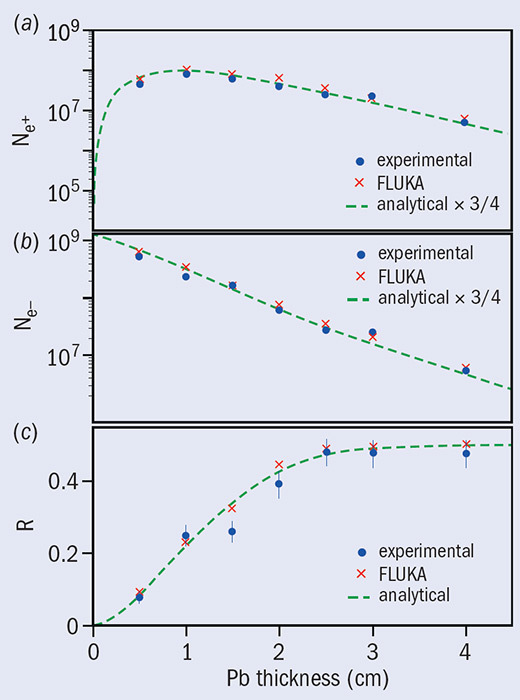
More than 99% of the visible universe exists as plasma, the so-called fourth state of matter. Produced from the ionization of predominantly hydrogen- and helium-dominated gases, these electron–ion plasmas are ubiquitous in the local universe. An exotic fifth state of matter, the electron–positron plasma, exists in the intense environments surrounding compact astrophysical objects, such as pulsars and black holes, and until recently, such plasmas were exclusively the realm of high-energy astrophysics. However, an international team, led by Gianluca Sarri of Queen’s University of Belfast, together with collaborators in the UK, US, Germany, Portugal and Italy, has at last succeeded in producing a neutral electron–positron plasma in a terrestrial laboratory experiment.
Electron–positron plasmas display peculiar features when compared with the other states of matter, on account of the symmetry between the negatively charged and positively charged particles, which in this case have equal mass but opposite charge. These plasmas play a fundamental role in the evolution of extreme astrophysical objects, including black holes and pulsars, and are associated with the emission of ultra-bright gamma-ray bursts. Moreover, it is likely that the early universe in the leptonic era – that is, in the minutes following approximately one second after the Big Bang – consisted almost exclusively of a dense electron–positron plasma in a hot photon bath.
While production of positrons has long been achievable, the formation of a plasma of charge-neutral electron–positron pairs has remained elusive, owing to the practical difficulties in combining equal numbers of these extremely mobile charges. However, the recent success was made possible by looking at the problem from a different perspective. Instead of generating two separate electron and positron populations, and recombining them, it aimed to generate an electron–positron plasma directly, in situ.
These results represent a real novelty for experimental physics, and pave the way for a new experimental field of research.
In an experiment at the Central Laser Facility at the Rutherford Appleton Laboratory in the UK, Sarri and colleagues made use of a laser-induced plasma wakefield to accelerate an ultra-relativistic electron beam. They focused an ultra-intense and short laser pulse (around 40 fs) onto a mixture of nitrogen and helium gas to produce, in only a few millimetres, electrons with an average energy of the order of 500–600 MeV. This beam was then directed onto a thick slab of a material of high atomic number – lead, in this case – to initiate an electromagnetic cascade, in a mainly two-step process. First, high-energy bremsstrahlung photons are generated as electrons or newly generated positrons propagate through the electric fields of the nuclei. Then, electron–positron pairs are generated during the interactions of the high-energy photons with the same fields. Under optimum experimental conditions, the team obtained, at the exit of the lead slab, a beam of electrons and positrons in equal numbers and of sufficient density to allow plasma-like behaviour.
These results represent a real novelty for experimental physics, and pave the way for a new experimental field of research: the study of symmetric matter–antimatter plasmas in the laboratory. Not only will it allow a better understanding of plasma physics from a fundamental point of view, but it should also shed light on some of the most fascinating, yet mysterious, objects in the known universe.
• The Central Laser Facility is supported by the UK’s Science and Technology Facilities Council. This experiment is supported by the UK’s Engineering and Physical Science Research Council.





